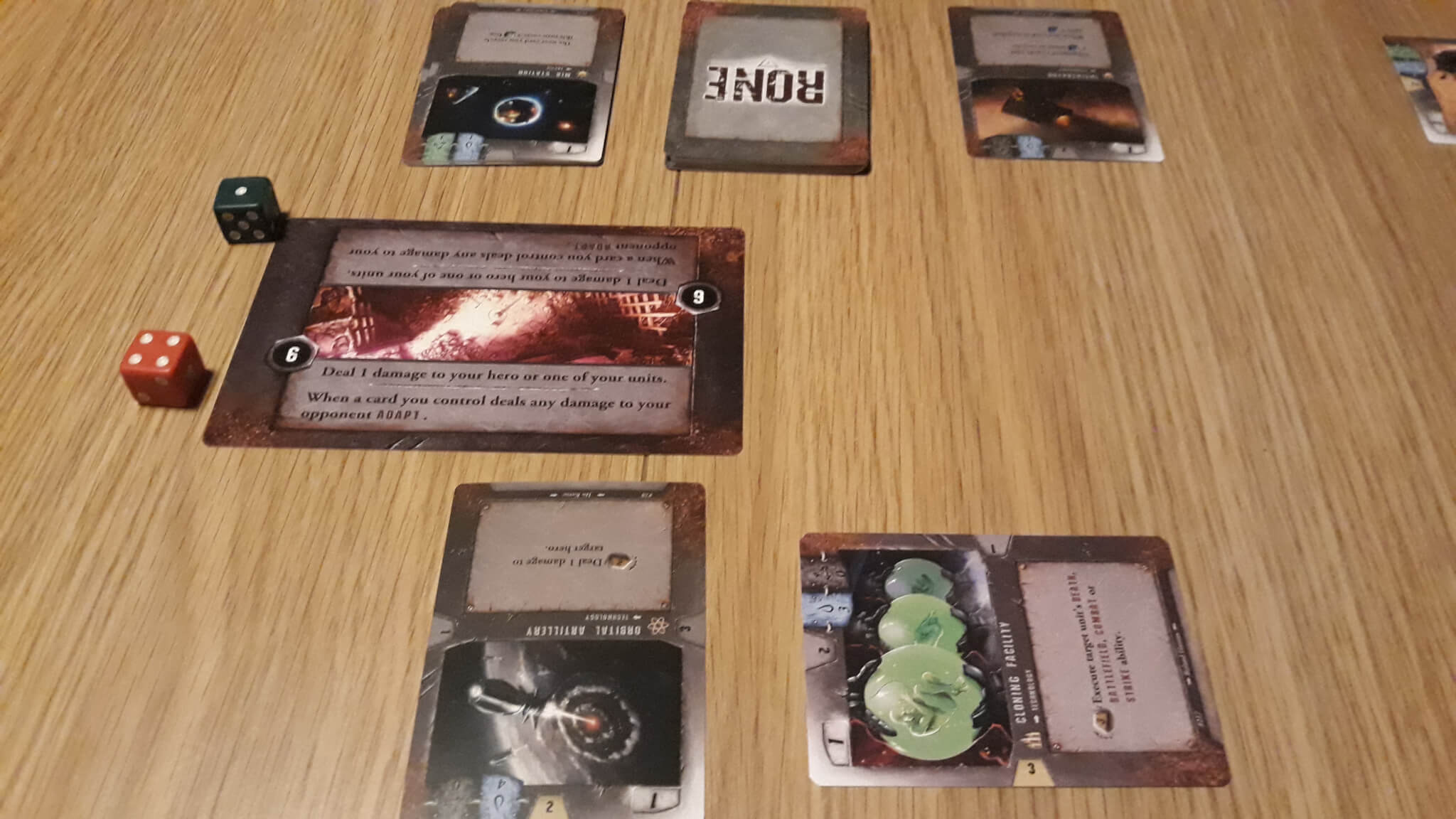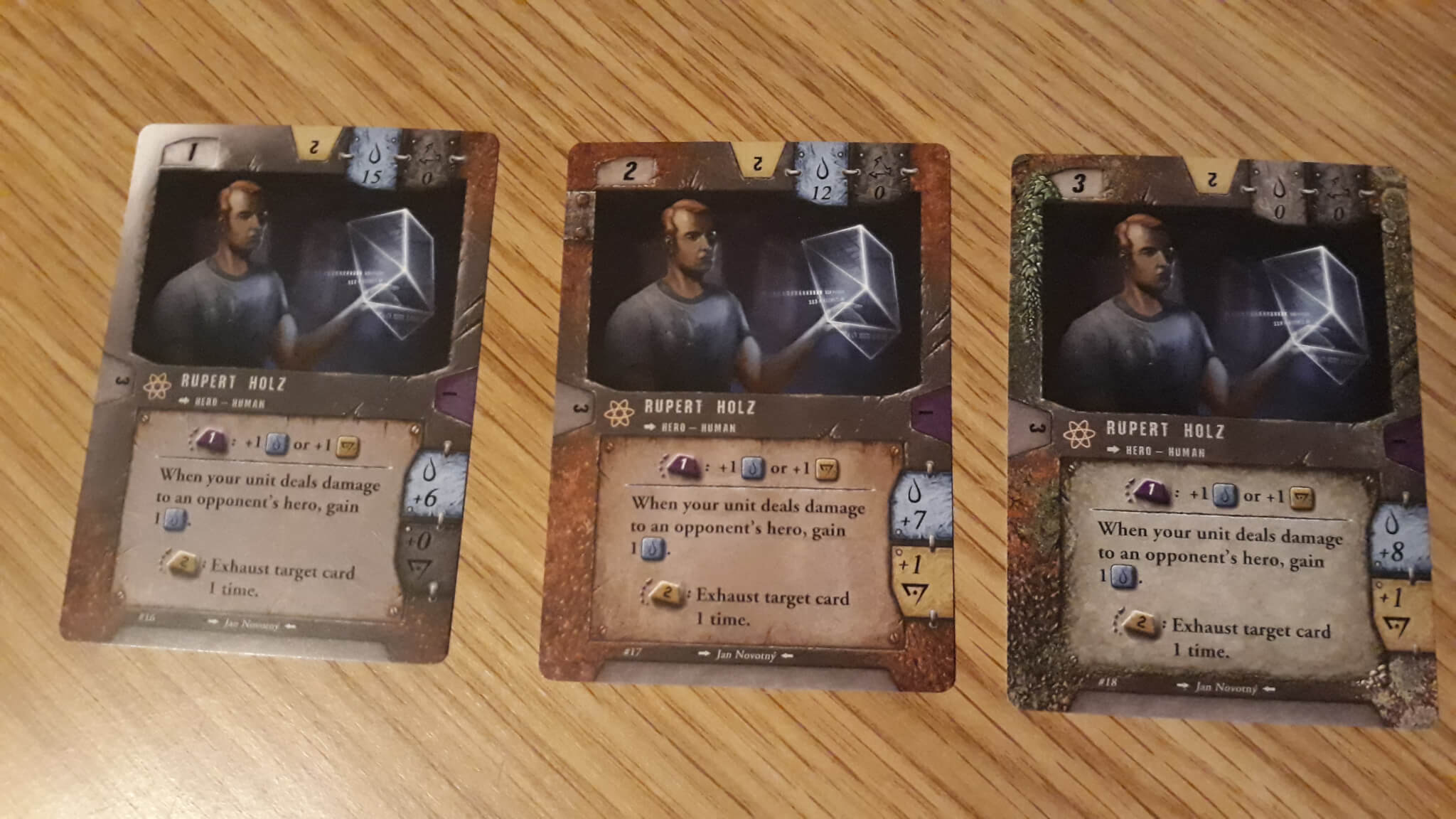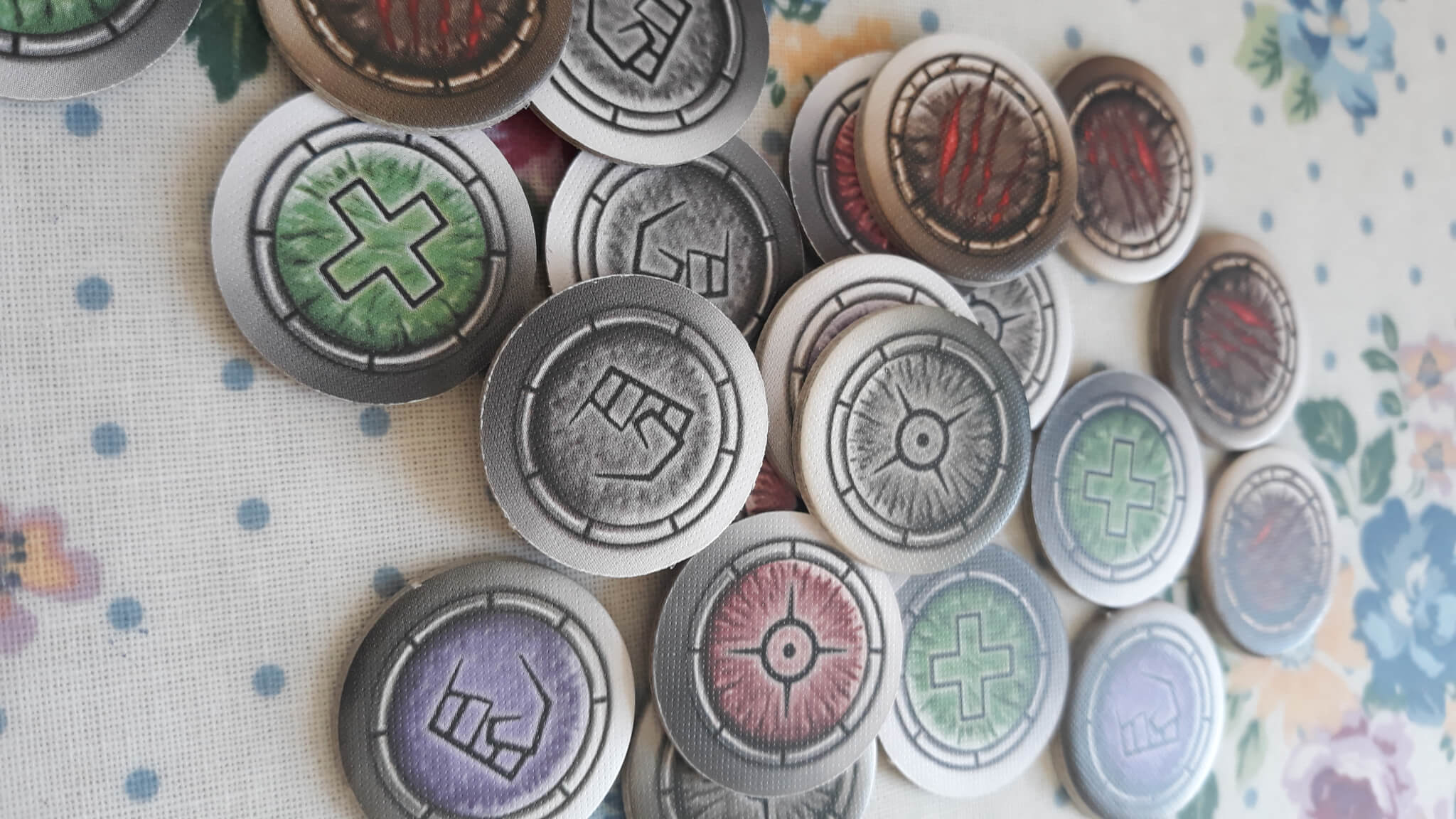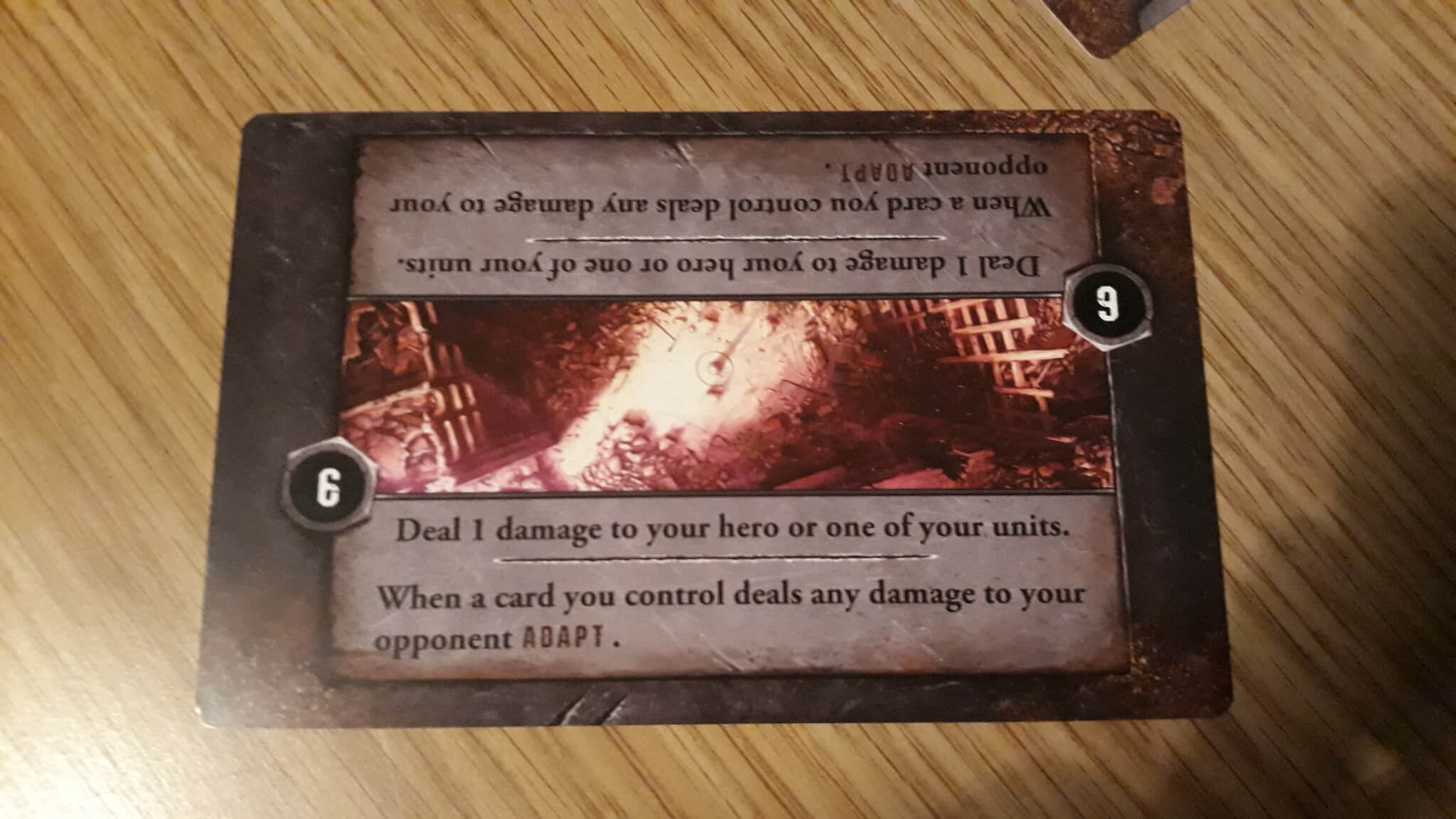RONE 2e — Tidy boxful of post-apocalyptic aggression
![]() In RONE (Races of a New Era) 2 players face off across a post-apocalyptic landscape in a battle for supremacy. Each player has a hero with unique abilities and they must deploy units, tactics and technologies to bring about a grisly end for their opposing hero.
In RONE (Races of a New Era) 2 players face off across a post-apocalyptic landscape in a battle for supremacy. Each player has a hero with unique abilities and they must deploy units, tactics and technologies to bring about a grisly end for their opposing hero.
The second edition of RONE, from Greiferisto games, came through Kickstarter in a 2017 campaign offering updated graphics, design, production and a new rulebook along with a New Forces expansion bringing fresh cards players could use to enhance their chances of victory. Being a head-to-head, deck-building game, cards is what RONE is all about. Anyone with a passing familiarity with Magic the Gathering or any of Fantasy Flight’s living card games (such as Netrunner, Arkham Horror or Warhammer 40,000: Conquest) will be pretty familiar with what is happening in RONE but the new kid on the block does have some tricks up its sleeve.

The first thing that happens each turn is that players receive their income in the form of water (used to pay the cost to play cards from your hand to the battlefield) and cards drawn from your deck. The hero that you have chosen to use for the game will dictate how much income you receive and, to add an extra spice, the heroes can improve over the course of the game, increasing income. Once you’ve received your income you will refresh (or “untap” in Magic parlance) your units, heroes and technologies once each. Your cards can end up exhausted (or tapped) as a result of using their special abilities or attacking opposing units and it is here that the first twist on the tried and trusted MtG formula comes through. Cards can actually exhaust more than once, resulting in them spinning around 180 or even 270 degrees and taking a consequently large number of turns to refresh all the way to ready status again. Judging whether an effect is worth the recovery cost it will incur is a big part of the strategy in RONE.
After you’ve received your income and refreshed your cards you enter the main phase of your turn where you can take any number of what the game terms “slow” actions. The difference between slow and quick effects in RONE is fairly straightforward and basically amounts to whether you can take the action or play the card only in the main phase on your turn or at any other time, even during an opponent’s turn. By default, Tactics cards (these provide one-shot effects then head straight to your discard pile) and abilities on Units and Technologies in play are fast effects and everything else is a slow effect. That means that playing Units and Technologies to the battlefield, leveling up your Hero and attacking your opponent can only happen during your Main phase on your turn.
Choosing when, how and with what to attack is another cornerstone of RONE and will be dictated by the state of the battlefield. When you pick a Unit to attack with you must exhaust it a number of times as stated on the card. This is usually three, occasionally two and rarely one. As a result, attacking is not something to be done lightly as you will be taking your Units out of commission for multiple turns normally. Once you have picked a Unit to attack with you will choose a target. If your opponent has ready (i.e. un–exhausted) Units then you can only attack those units, otherwise you are free to attack whichever Unit you wish or even the opponent’s Hero directly.

Units deal damage according to a simple Melee and Ranged attack value that each card has, with Ranged damage being dealt first and then Melee. All damage is simultaneous so unless your Unit has enough Ranged damage to destroy the target you can expect your attackers to take some damage back. When it comes to attacking Heroes, damage works differently with the opponent having to either discard a card from hand or from the top of their deck for each damage they take. This brings us neatly onto winning a game of RONE. When there are no more cards in your deck or in your hand your Hero has been defeated and victory belongs to your opponent. Decks in RONE are only twenty four cards strong so it can feel like you are withering away at an alarming speed during the game and each hit definitely hurts, taking away what are already quite limited resources. A downside to this otherwise neat method is that it can feel very hard to come back from a weaker position at the end of the game as playing cards hurts you as much your opponent.
The good news here though is that cards in your discard pile (whether they got there from damage taken by your Hero, Units being destroyed on the battlefield or Tactics being played from hand) are not a lost resource to you. Alongside the water cost to play from hand, each card also has a recycle cost. If you pay this recycle cost (by removing that number of cards from your discard pile from the game) then you can play the card again. If it is a Unit it returns to the battlefield (albeit exhausted twice), if it is a Tactic you get the effect again then the card is removed from the game entirely.
Recycling is big game in RONE and choosing what to recycle and when adds a lot of strategic depth. A nice touch in this regard is that, when a card enters the discard pile, you can choose whether to put it on the top (you can only recycle the top card of your discard pile) or on the bottom (meaning you’re more likely to end up losing the card as a cost to recycle something else). Some great stuff can be done with this mechanic. It’s possible to chain off recycles if you make the right choices, putting cards on the top and the bottom so that you can recycle the top card, burn the cards underneath and be left with the next card you want to recycle on the top of your discard pile. When you pull that sort of thing off is one of the times that RONE feels most satisfying.

In terms of its components, the card stock for RONE is high-quality and the art is, by and large, very nice and evocative of popular post-apocalyptic games such as Wasteland 2 or Fallout. There does exist a disconnect between mechanics and art however. Oftentimes it feels as though the effect of a card in the game doesn’t necessarily fit with what the art is suggesting the Unit or Tactic should accomplish. It is possible that our expectations are too high on this front as it is a big task to dovetail the two elements together perfectly, particularly when dealing with a game that comes with hundreds of different cards in the box.
That depth in the box contents is a big boon though. The rulebook suggests that you play with entirely random decks of 24 cards and, whilst this does work surprisingly well, the real meat of the game is in the deck-building; finding combinations and synergies that propel your deck to the next level. It would certainly be possible to spend hours rooting through the box trying to put together the perfect incarnation of a deck idea if one were of a mind to.
If it seems like we’ve referenced Magic: the Gathering a few times in this review that is because RONE feels very similar to the grandfather of CCGs, with a lot of the lessons learned over 20-plus years of MtG development being applied directly to the gameplay. For every time that RONE takes a concept directly from Magic,though, there is an instance of the developers innovating and trying new things, blending tried-and-tested concepts with new thinking and interesting twists. One of the weakest elements of Magic is the reliance on land-drawing and density to drive the ability to play the cards in your hand. Not many CCGs or LCGs have a similar mechanic to this anymore and RONE correctly identifies this as something that can be cut while the “stack” concept of effect resolution is taken directly from Magic as something that works extremely well.

Overall, RONE feels like a very good introductory game to investigate CCG and LCG–style gameplay. A big barrier of entry to those games is the high investment cost to start playing and the constantly-felt need to buy the newest cards to keep up with the meta. As a product that comes almost entirely within one box as a complete game, RONE has none of that and yet is stacked with enough tactical, strategic and deck-building choice not to leave you feeling shortchanged. If you’re somebody already steeped in CCG or LCG gameplay though you may find that RONE cannot compete with the experience you get from the games you have already invested in..
Note: We played RONE 2e with the upcoming and final expansion, The Last Stand. This expansion offers a bunch of new cards and a new interesting gameplay twist in the form of environments. These force the player to make sacrifices or take specific actions to adapt to them, punishing the player who adapts least well. The environments add a fresh layer of strategy to the game, however we found that they could also add a fairly random element to play with some environments benefiting one deck much more than another. The increased longevity they add to the life of RONE as a complete game makes it worth investigating though. The Last Stand is coming to Kickstarter in 2020.
You can pre-order RONE 2nd Edition and RONE: New Forces on their Kickstarter page.

Comments are closed.